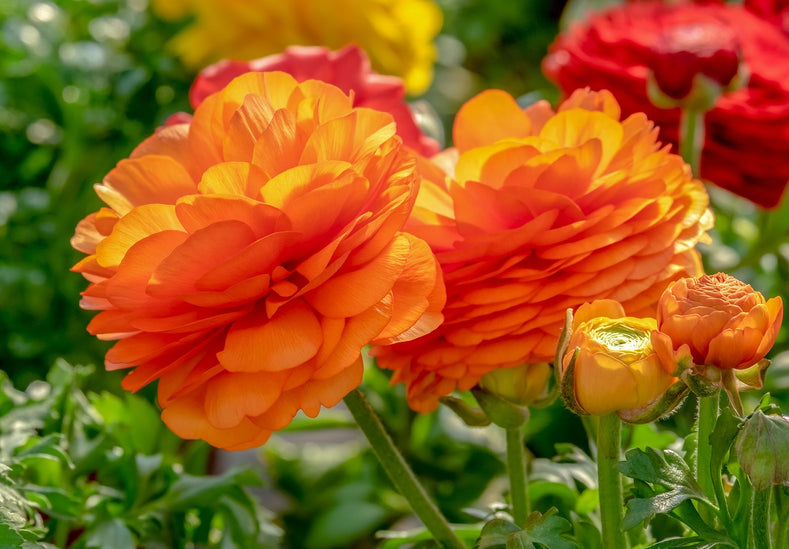Ranunculus, known for their gorgeous, layered blooms, are a popular choice for gardeners looking to add vibrant colors to their spring gardens. While these flowers are relatively easy to grow, they are sensitive to freezing temperatures, so careful planning is essential. Below is a comprehensive guide on planting ranunculus bulbs in the fall based on your USDA hardiness zone.
1. Understanding Your USDA Hardiness Zone
- Zones 8-10: In these warmer zones, you can plant ranunculus bulbs in the fall for early spring blooms. The mild winter temperatures allow the bulbs to establish roots without the risk of frost damage.
- Zones 3-7: These cooler zones experience harsher winters with freezing temperatures. If you live in one of these zones, it's better to plant your ranunculus bulbs in late winter or early spring to avoid frost damage. Fall planting in these zones is not recommended unless you can provide adequate frost protection.
Storing in Zones 3-7: Once you receive your bulbs in the fall, store them in paper bags in a cool, dry place like a basement, garage, or kitchen until planting time in late winter or early spring.
2. Preparing Your Ranunculus Bulbs
Before planting, you'll need to prepare your ranunculus bulbs to ensure they are ready for planting.
- Soaking the Bulbs:
- Soak the bulbs in room temperature water for about 3-4 hours. This helps to rehydrate the bulbs, encouraging quicker root development once planted.
- After soaking, you can pre-sprout the bulbs by placing them in a tray of slightly damp peat moss or soil in a cool, dark place for about 10 days. This step is optional but can give the bulbs a head start.
3. Selecting and Preparing the Planting Site
Ranunculus thrive in well-draining soil and full sunlight. Here’s how to prepare the site:
- Soil Preparation:
- Choose a site with well-draining soil; soggy soil can cause the bulbs to rot.
- Amend the soil with organic matter, such as compost, to improve drainage and nutrient content.
- Test the soil pH if possible. Ranunculus prefer a slightly acidic to neutral pH (6.0-7.0).
- Sunlight Requirements:
- Plant ranunculus in a location that receives full sun (at least 6 hours of direct sunlight per day).
4. Planting the Bulbs
- Planting Depth:
- Plant the bulbs about 2-3 inches deep, with the pointed end facing downward. Space the bulbs about 4-6 inches apart to allow room for the plants to grow.
- Watering:
- After planting, water the bulbs thoroughly to help settle the soil and encourage root growth.
- Continue to water regularly, keeping the soil consistently moist but not waterlogged.
5. Frost Protection (for Zones 8-10)
While Zones 8-10 typically have mild winters, unexpected cold snaps can still occur.
- Mulching:
- After planting, apply a layer of mulch (such as straw or leaves) over the planting area to help insulate the bulbs and protect against any unexpected frost.
- Frost Cloths:
- If temperatures are expected to drop significantly, consider covering the planted area with frost cloths or row covers to protect the bulbs.
6. Winter Care
- Monitoring:
- Keep an eye on the weather. In mild winter zones, ranunculus will continue to develop roots during the cooler months. If a frost is expected, ensure that the bulbs are adequately protected.
- Watering:
- Continue watering the bulbs during dry periods throughout the winter, but avoid overwatering as this can lead to rot.
7. Spring Growth and Flowering
- Growth:
- As temperatures warm in early spring, you’ll notice shoots emerging from the soil. Continue watering regularly and apply a balanced fertilizer every few weeks to encourage healthy growth.
- Blooming:
- Ranunculus usually begin to bloom in late spring. The flowers can last several weeks, providing a beautiful display of color in your garden.
- Post-Bloom Care:
- After blooming, allow the foliage to die back naturally, as this helps the bulbs store energy for the next growing season.
- In Zones 8-10, you can leave the bulbs in the ground, but in Zones 3-7, it's best to lift and store the bulbs in a cool, dry place if you planted them in late winter/early spring.
8. Storing the Bulbs (for Zones 3-7)
- Lifting the Bulbs:
- After the foliage has died back, carefully dig up the bulbs. Brush off any excess soil and let them dry in a cool, dry place for a few days.
- Storing:
- Store the dried bulbs in a paper bag or a container with ventilation in a cool, dry place until the next planting season.
By following this guide, you can successfully plant and grow ranunculus bulbs in the fall, enjoying their stunning blooms in the spring. Happy gardening!


